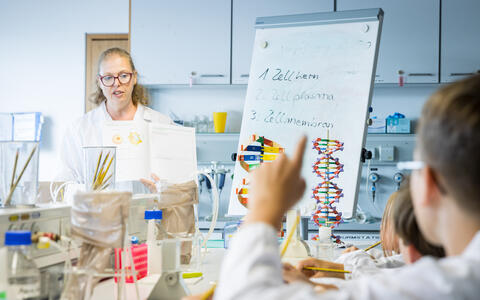The thrill of science
Emilio at the microscope.
Emilio is in seventh grade and wants to study reptiles when he grows up. He has three geckos and a tortoise, and he is planning to learn Latin in high school to prepare him for a career in science. So a visit to the Gläsernes Labor on Campus Berlin-Buch was the perfect opportunity for Emilio. His friend Damian had asked him if he wanted to come along: “He told me we’d be able to look at the DNA in our spit. That sounded interesting.”
- Gläsernes Labor
-
-
The Gläsernes Labor (Life Science Learning Lab) is a youth education center run jointly by the Max Delbrück Center, the Leibniz-Forschungsinstitut für Molekulare Pharmakologie (FMP) and Campus Berlin-Buch GmbH. It offers more than 20 experimental courses in molecular biology, cell biology, neurobiology, chemistry, radioactivity, and ecology for schoolchildren. With around 14,000 participating students each year, Gläsernes Labor is one of the best-attended out-of-school science education centers in the whole of Germany.
A day in the lab for 48 kids
Emilio and Damian are two of 16 children aged between seven and 14 in this group who usually attend the Marzahn-Mitte youth club JFE FAIR run by the Berlin-Brandenburg branch of the Humanist Association of Germany. Max Delbrück Center employees donated money to finance a trip to the laboratory for the children. “We raised an incredible €1,495,” says Feraye Kocaoglu. “That’s twice as much as our fundraising goal.” Kocaoglu works as an administrative assistant for several research labs at the Max Delbrück Center and regularly organizes fundraisers along with Victoria Malchin, who is responsible for site management at MDC-BIMSB. The money raised paid for two groups of schoolkids – one from JFE FAIR and another from the Elisabethstift children’s home – to spend a day at the Gläsernes Labor getting a taste of what it’s like to work in science. The lab days cost €30 per child, but many families can’t afford that.
The JFE FAIR youth club offers around 200 children a positive space to spend their free time – learning an instrument, acting, making handicrafts, doing sport, or simply completing their homework. Many of the children come from socially disadvantaged families and rarely get the chance to leave their own neighborhood. The Max Delbrück Center has been donating Christmas gifts to the Elisabethstift for many years now, and two years ago it began doing the same for the Humanist Association. When Kocaoglu and Malchin took the gifts to JFE FAIR in person last year they decided they wanted to enable the children to spend a day at the Gläsernes Labor. They therefore organized the fundraising campaign in collaboration with the Society of Friends of the Max Delbrück Center.
Soap bubbles and DNA strands
“We were delighted to receive the invitation,” says Anika Schmidt, director of JFE FAIR. The day out made a great change for the children, she says. Even the train ride from Marzahn to Buch was a big adventure for them. “We got to know another side to the children and gained an impression of what they are like in a school setting.” The younger children, aged six to nine, had lots of fun experimenting with air, water and soap bubbles. One of the highlights of their investigations was the “tornado in a soda bottle.” To create that, course leader Ilona Kurth takes two empty soda bottles, fills one with water, connects the two bottles with a special seal, and places them on the table with the full bottle on top. As the water trickles down, air bubbles rise up, gradually forming a vortex that spins faster and faster until a mini-tornado forms inside the bottle.
In the meantime, the ten to 14-year-olds were busy with some onions. Under the instruction of Claudia Jacob, head of the Gläsernes Labor, they peered at pieces of onion skin through a microscope and then carefully drew the cells, their brows furrowed in concentration. Next, they swiped a cotton bud on the inside of their cheek, dabbed the moisture on a microscope slide, and carefully examined the results. They didn’t just see spit – they discovered cells from their own mucus membrane. They drew these too and then compared them with the onion cells. Somehow, human cells appear less spectacular than plant cells – no cell wall, no vacuoles, no chloroplasts. But, Jacob assured them, deep inside the cell nucleus, genetic information is lurking – in their own cells and that of the onion. “We will isolate the DNA after the break,” she said. “But to do that we will use a plum.” In that moment Emilio realized they wouldn’t actually be looking at their own DNA, but he was still excited. A career in science seems more appealing than ever before.
Text: Jana Ehrhardt-Joswig














